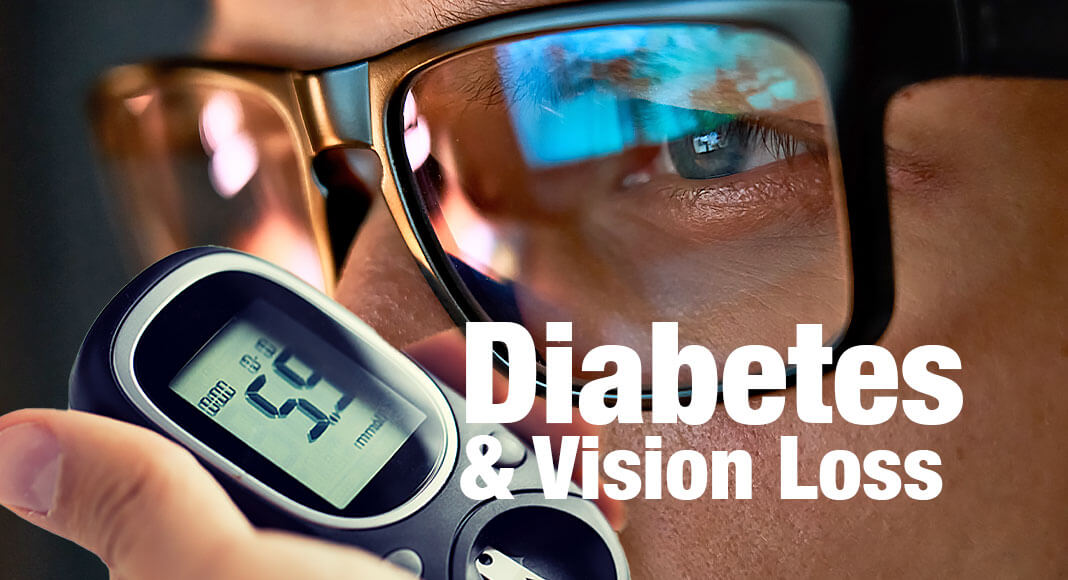
CDC – Diabetes can damage your eyes over time and cause vision loss, even blindness. The good news is managing your diabetes and getting regular eye exams can help prevent vision problems and stop them from getting worse.
Eye diseases that can affect people with diabetes include diabetic retinopathy, macular edema (which usually develops along with diabetic retinopathy), cataracts, and glaucoma. All can lead to vision loss, but early diagnosis and treatment can go a long way toward protecting your eyesight.
Diabetic Retinopathy
This common eye disease is the leading cause of blindness in working-age adults. Diabetic retinopathy is caused when high blood sugar damages blood vessels in the retina (a light-sensitive layer of cells in the back of the eye). Damaged blood vessels can swell and leak, causing blurry vision or stopping blood flow. Sometimes new blood vessels grow, but they aren’t normal and can cause further vision problems. Diabetic retinopathy usually affects both eyes.
Risk Factors for Diabetic Retinopathy
Anyone with type 1, type 2, or gestational diabetes (diabetes while pregnant) can develop diabetic retinopathy. The longer you have diabetes, the more likely you are to develop it. These factors can also increase your risk:
- Blood sugar, blood pressure, and cholesterol levels that are too high.
- Smoking.
- Race/ethnicity: African Americans, Hispanics/Latinos, and American Indians/Alaska Natives are at higher risk.
Stages of Diabetic Retinopathy
Diabetic retinopathy has 2 main stages:
Early stage (nonproliferative): Blood vessel walls in the retina weaken and bulge, forming tiny pouches (you won’t be able to detect them, but your eye doctor can). These pouches can leak blood and other fluid, which can cause a part of the retina called the macula to swell (macular edema) and distort your vision. Macular edema is the most common cause of blindness in people with diabetic retinopathy. About half of people with diabetic retinopathy will develop macular edema.
Advanced stage (proliferative): In this stage, the retina begins to grow new blood vessels. These new vessels are fragile and often bleed into the vitreous (the clear gel between the lens and retina). With minor bleeding, you may see a few dark spots that float in your vision. If there’s a lot of bleeding, your vision may be completely blocked.
You may not notice symptoms in the early stage. That’s why it’s very important to get a dilated eye exam at least once a year to catch any problems early when treatment is most effective.
Symptoms in the advanced stage can include:
- Blurry vision
- Spots or dark shapes in your vision (floaters)
- Trouble seeing colors
- Dark or empty areas in your vision
- Vision loss
How Diabetic Retinopathy Is Diagnosed
During your eye exam, your eye doctor will check how well you see the details of letters or symbols from a distance. Your doctor will also look at the retina and inside of your eyes and may use a dye to reveal leaky blood vessels. If it turns out you have diabetic retinopathy, your eye doctor may want to check your vision more often than once a year.
You should be checked for diabetic retinopathy immediately if you’re diagnosed with type 2 diabetes. If you have type 1 diabetes, you should be checked within 5 years of your diagnosis and then regularly thereafter, typically every year. The sooner you’re treated for diabetic retinopathy, the better that treatment will work.
Call your eye doctor if you notice changes in your vision, especially if they happen suddenly. Changes may include:
- Blurring
- Spots
- Flashes
- Blind spots
- Distortion
- Difficulty reading or doing detail work
Diabetic Retinopathy Treatment
Treating diabetic retinopathy can repair damage to the eye and even prevent blindness in most people. Treatment can start before your sight is affected, which helps prevent vision loss. Options include:
- Laser therapy (also called laser photocoagulation). This creates a barrier of scar tissue that slows the growth of new blood vessels.
- Medicines called VEGF inhibitors, which can slow down or reverse diabetic retinopathy.
- Removing all or part of the vitreous (vitrectomy).
- Reattachment of the retina (for retinal detachment, a complication of diabetic retinopathy).
- Injection of medicines called corticosteroids.
Prevent or Delay Eye Diseases
You can protect your vision and lower your chance for vision loss with these steps:
- Get a dilated eye exam at least once a year so your eye doctor can spot any problems early when they’re most treatable.
- Keep your blood sugar levels in your target range as much as possible. Over time, high blood sugar not only damages blood vessels in your eyes, it can also affect the shape of your lenses and make your vision blurry.
- Keep your blood pressure and cholesterol levels in your target range to lower your risk for eye diseases and vision loss. Also good for your health in general!
- Quit smoking. Quitting lowers your risk for diabetes-related eye diseases and improves your health in many other ways too.
- Get active. Physical activity protects your eyes and helps you manage diabetes.
- Ask your doctor for a referral to diabetes self-management education and support (DSMES) services. People who receive less diabetes education are twice as likely to get diabetic retinopathy as people who receive more education.
Get Your Eyes Checked
Eye problems are common in people with diabetes, but treatments can be very effective. Only your eye doctor can diagnose eye diseases, so make sure to get a dilated eye exam at least once a year. The earlier eye problems are found and treated, the better for your eyesight.








